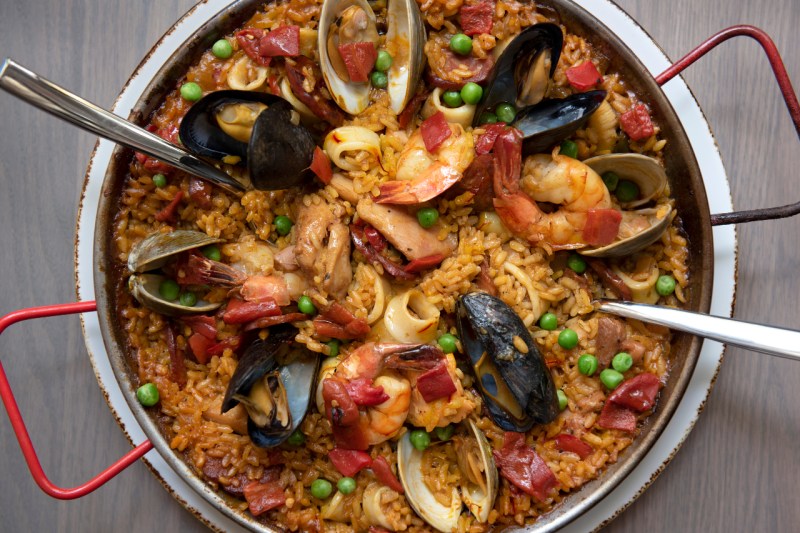
While French and Italian wines might be better known globally, Spanish wines are some of the best in the world and deserve equal recognition. The cuisine of Spain is incredibly diverse and home to some of the most celebrated food cities in the world. A critical element of Spanish cuisine is the seafood, which ranges from tapas to colorful paella packed with shellfish. Because of this flair for ocean flavors, it should come as no surprise that Spanish wines are an elegant and complex pairing with seafood.
Enter Latin-Caribbean Tasca restaurant, located in the Upper West Side of Manhattan. The brainchild of restaurateur Jay Espinal and his wife Norisa, Tasca is their attempt at creating an authentic and elevated Latin-Caribbean restaurant. The food at Tasca is a rich tapestry of Spain, Cuba, the Dominican Republic, and Puerto Rico. While their meats and vegetables are superbly executed, the menu truly shines when it comes to the seafood. First-class dishes like grilled octopus with purple potatoes and shrimp with wild mushrooms are impeccably cooked and especially delicious paired with a glass of Spanish wine from Tasca’s impressive wine program.
“We tried to have the wine list be representative of the restaurant with a New World and Old World contrast,” said Espinal. “80% of the wine list is from Spain. The wine was curated by tasting over 5,000 bottles with trips to Spain and over 30 trade events and tastings.”
Intro to Spanish Wines

The scale of Spanish wines is immense with an endless amount of variations, styles, and flavors. To understand Spanish wines, the first thing to grasp is the regions. Wines in Spain are defined by their regions or D.O.(denomination de Origen), with each D.O. having its own rules for wine-making (such as which grapes can be planted). A great element about Spanish wines is that even if the regions use similar grapes, the variations are endless. “The beauty of Spain is that the same Tempranillo (wine grape variety) has a completely different representation from different D.O.’s or regions,” said Espinal.
The Main Wine Regions of Spain
Priorat Region
This region in northeastern Spain is well-known for big, opulent, earthy, and mineral-rich wines.
Ribera del Duero Wine Region
Located in the northern plateau of Spain, Ribera del Duero uses many old vine Tempranillo grapes (known in the region as “tinto fino”). This region is infamous for its hot days and cool nights, all excellent conditions for grapes.
Bierzo Wine Region
Bierzo is located in the northwest province of León. Here, the cooler climate is ideal for Mencia grapes, producing medium-bodied wines with plenty of minerality.
Rioja Wine Region
Considered by some to be the definitive wine region of Spain, Rioja is famous for their Tempranillo grapes and oak barrels (the traditional style are aged in American oak barrels while the modern style is aged in French oak.)
Jerez Wine Region
Located in the southern tip of Spain, this area is known for sherries, very dry manzanilla, and sweet, opulent Pedro Ximenez.
The Best Spanish Wine Pairings for Seafood

Since seafood is a huge part of Spanish cuisine, the number of possible wine pairings are endless when it comes to Spanish wines. Seafood, from white fish to briny shellfish and oily mackerel, all pair with different wines that can accentuate those flavors. Personally, Espinal is partial to Godello, a white wine from Valdeorras for oily fish. With shellfish, he advises a Xarello, Txakoli, or a crisp Albariño depending on the preparation.
Generally, white wine is considered the ideal pairing for seafood. White wine is more acidic (similar to lemon juice on fish) and a natural complement to seafood. In comparison, red wine is often paired with steak or other meats. Red wines are rich in tannins which help cut through the fat and heaviness of red meat, allowing the wine to release more of its complex fruit flavors.
However, in Espinal’s opinion, this common advice isn’t always the case. “I like Descendiente de los Palacios Corullon Moncerbal as a red with seafood,” said Espinal. “Their whole lineup from Bierzo actually goes well with seafood.”
What to Purchase
If you’re interested in trying out Spanish wines for yourself, Espinal recommends starting first with the main regions of Ribera del Duero, Rioja, Priorat, and Bierzo. For white wines, he suggests Rías Baixas, Rueda, and Penedes.



